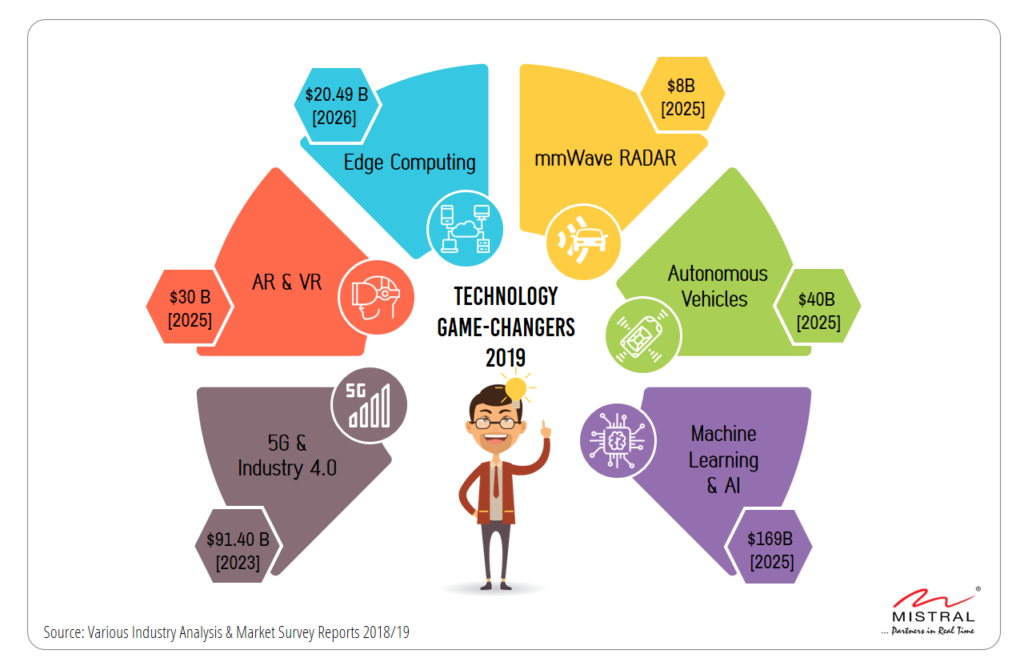Anticipating 2019’s game-changing technologies!
As we welcome a brand new year, I am thinking and looking forward to the top tech trends of 2019. Of course, there are lot of new things coming up like blockchain and quantum computing, but I am interested to look at something that is closer to the industries and domains that we operate that’s going to have significant impact starting 2019.

5G and Industry 4.0
With cyber-physical systems becoming a reality and machines becoming intelligent with host of sensors with edge computing and cloud computing enabling decentralized decision making, 5G is going to play a very vital role in this transformation. The need of the day is ultra-reliable low latency communication replacing the existing wireline communication with a very high bandwidth 5G network which will enable applications like Predictive maintenance, Remote quality inspection with high resolution or 3D Videos, real-time machine-to-machine communication and Robots which will increase the efficiency, decrease the downtime and quadruple the productivity. As of today, many of these Industry 4.0 and Industrial IoT applications are getting ready for the prime time and we should see the acceleration of adoption with the deployment of 5G network starting 2019. With the Industrial IoT market size estimated to be $91.40 Billion by 2023, we are truly looking at a game changer and the next biggest thing in manufacturing since the Industrial revolution.
AR / VR
The glasses (HMD, Smart Glasses, HUD) market has been around for a while now. Companies are still trying to figure out the business model, building an eco-system, developing channels etc. Over the last couple of years there has been heightened activity in this domain with many new product releases. But there are also many companies that are falling on the way side including the ones that have got some very cool technology. However, there has been some very good developments too. Microsoft closed a large deal with US Defense for their Hololens and services recently. There are players who are making waves in the enterprise market. However, it looks like we are reaching the tipping point wherein the volumes for the AR glasses will start growing. The companies will move from PoC to deployment. The areas of deployment are going to be in Industry shop floor, employee training, remote technical support, logistics, enhanced customer experience in retail, aerospace and medical. The volumes are going to be driven by the enterprise sector with the market projection for these glasses in this sector estimated to grow to $30 Billion by 2025. The winners are going to be those who will have laser sharp focus on their customers in their chosen market space with a viable business model and with an emphasis on shipping a finished product. The rest will be consigned to the dustbin of history.
Edge computing
Edge computing also referred to as fog computing is using edge devices to carry out substantial amount of computation locally in an enterprise as opposed to having everything done in a central cloud environment. There has been debate about edge computing for some time and it looks like edge computing is making rapid strides in gaining popularity. Some of the factors working in favor of edge computing are enhanced security, improving QoS, real-time decision making, stringent latency and capacity constraints. In IoT and industrial IoT deployments, sending all the data to the cloud requires prohibitively high network bandwidth. In edge computing, massive amounts of data generated by various devices can be processed on the network edge and transfer only the required data (which can be further encrypted to allay security concerns) into the central cloud. This in turn leads to faster response and greater QoS compared to central cloud processing. Edge computing can be applied to varied and broad spectrum of applications like Industrial Robots, factory floor, alongside a railway track or even on top of power pole. According to Stratistics MRC, Global Edge Computing Market accounted for $7.98 Billion in 2017 and expected to grow to $20.49 Billion by 2026 at a CAGR of 11%.
mmWave RADAR
Millimeter wave (mmWave) is a band of spectrum between 30 gigahertz (GHz) and 300GHz. mmWave radars will be adopted in a major way in automotive and Industrial segments. Billions of dollars are being invested in this domain. Technology, silicon and automotive companies are working on mmWave to bring out products that are going to be used in our everyday lives. Cars to Industrial equipment to autonomous vehicles will be using this technology in a big way. mmWave sensors combined with camera will create a large market for the automotive and Industrial segments. Some of the applications that mmWave radars will be driving are driver safety, ADAS, Adaptive Traffic signal control, Autonomous cars, lane departure warnings and a combination of mmWave radar and camera will be driving applications like adaptive traffic signal control, number plate capture, parking assistance, driver monitoring etc., The demand in the industrial space for mmWave sensors is going to come from robotics, building automation, security, industrial safe zone and free space monitoring. This nascent market is projected to hit >$8B by 2025.
Autonomous vehicles
Within a few years, autonomous cars have gone from science fiction / sci-fi movie stuff to road worthy reality. At this rate my 6-year-old may never need to learn driving and own a car. For any technology to be adopted and especially a technology like this one which is a combination of multitude of factors, we need an ecosystem of companies and not just automotive or one industry segment dabbling into this. Beyond the usual suspects like Tesla, Google and a host of auto companies many of the tech. heavy weights are investing in autonomous R&D. Amazon is experimenting with autonomous package delivery. Cisco started building autonomous driving infrastructure with Michigan DOT in 2017 and at CES 2018 announced a project to build technology bringing gigabit-speed connectivity to smart cars. Microsoft is pursing collaborative strategy with automakers offering azure cloud services to companies working on self-driving cars and working with some Tier 1s like Toyota, Volvo etc., This is just a sample. If we start looking into the investments and startups working on the autonomous domain, the list will run into many pages. Exciting times indeed!
Machine Learning and Artificial Intelligence
There is nothing new about ML and AI but the rate of adoption and how pervasive it is going to be in our everyday life is the talking point. Alexa and Google Home are already deployed in millions of homes. My six-year-old and ten-year-old feel more comfortable chatting with Google Home to find answers to their assignments. These technologies are no more niche but mainstream now and impacting billions of lives. If I can hazard a guess on the areas that are going to have larger impact and getting into larger deployments, it’s going to be computer vision or more specifically computer vision using deep learning; more break throughs in natural language processing (NLP); greater use of robots in our everyday lives and factories; and upgraded cybersecurity using ML and AI.
All of these are very exciting developments and there will be quantum leap be it with 5G or Industry 4.0 or ML and AI. These will not be just present in the realm of technology space but will make its presence felt in the in our day to day lives.
By Srinivas Panapakam, VP – Sales & Business Development (PES)
*Published on embedded.com on 31 Jan 2019 | View Article




